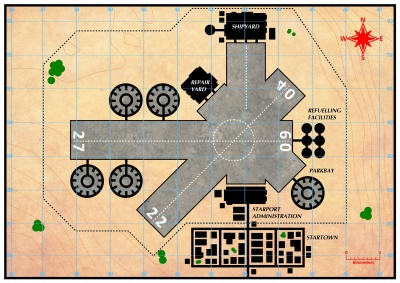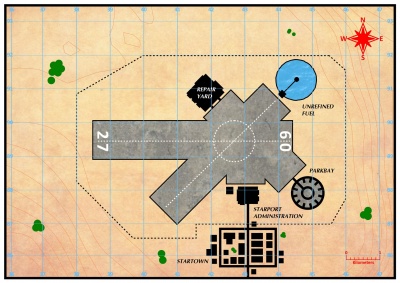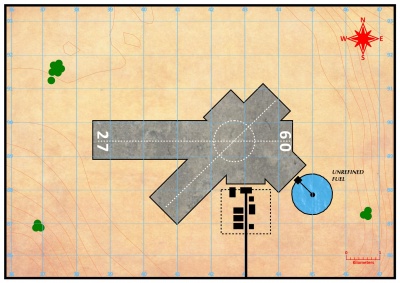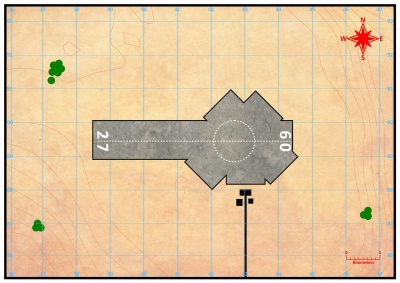Starport
Starports are established primarily to foster interstellar trade and commerce. [1]
- A Starport is an establishment or facility for the landing, servicing, refueling, launching, and control of starships.
- Starports range in quality from A (the best and most extensive) to E (the worst, little more than a spot of cleared ground), and X.
- Starports differ from spaceports in that they cater to interstellar starcraft with jump drives. Spaceports primarily handle system craft and non-FTL craft.
- A secondary set of spaceport ratings includes F, G, H, and Y.
Please see the following AAB Library Data for more information:
- Observing Charted Space
- Universal World Profile (UWP)
- Starport (Sp)
- Planetary Size (S)
- Atmosphere (A)
- Hydrosphere {H)
- Population (P)
- Government (G)
- Law Level (L)
- Tech Level (TL)
- PBG Sequence
- P: Pop Multipliers
- B: Belts
- G: Gas Giants
- TZ: Travel Zone
- COG Sequence
- Other System Data
- Universal World Profile (UWP)
Description (Specifications)
Starports and spaceports are given codes in the UWP for stellar systems.
UWP Starport Codes
The codes in general use are:
Starport UWP Codes Starport/Spaceport Codes Code Type Quality Shipyards Repair Refuel World Remarks A (Starport) Excellent Starships Overhaul Refined Mainworld Top of the line starport with extensive capability including FTL starship construction, overhauls, and where fuel of every type is readily available. - A-class starports almost always harbor major interstellar commerce. Many function as interstellar trade nexuses on a subsector or sector level.
B (Starport) Good Spacecraft Overhaul Refined Mainworld Good quality starport with most desired capabilities. - A B-class starport can service starships, but only has the capability to build spaceships, not interstellar FTL craft with jump drives. They are often otherwise very impressive ship ports.
C (Starport) Routine Minimal Major Unrefined Mainworld Routine quality starport with many desired capabilities. - C-class starports serve lower volume interstellar traffic, but haven't garnered enough trade to support larger and more capable ship support facilities.
D (Starport) Poor Minimal Minor Unrefined Mainworld Poor quality starport with few desired capabilities. - These tend to be backwater facilities with minimal interstellar trade.
E (Starport) Frontier None None Unrefined Mainworld Frontier quality starport with almost no desired capabilities. - These starports can service starships to a very limited degree and have not yet caught the eyes of interstellar developers.
F (Spaceport) Good Minimal Minor Unrefined Non-Mainworld A good quality spaceport that feeds the mainworld starport through intrasystem shuttle services. - F-class facilities often have significant colonies or mining operations and regularly see traffic from the mainworld. It's not uncommon for daily trips or even several times a day.
G (Spaceport) Poor None Superficial Unrefined Non-Mainworld A poor quality spaceport that feeds the mainworld starport through intrasystem shuttle services. - G-class facilities have limited connections with the mainworld and traffic might only exist once a week or less due to limited economic or cultural importance.
H (Spaceport) Primitive None None None Non-Mainworld A very primitive quality spaceport with little regular traffic or intrasystem commerce. - Often little more than a cleared area of open space with decent firmament. Little of interest to the mainworld or interstellar travellers.
X (Starport) None None None None Non-Mainworld A largely undeveloped world with great potential to later develop a starport. Y (Spaceport) None None None None Non-Mainworld A largely undeveloped world with potential to later develop a spaceport, but not a starport.
Starport vs. Spaceport
In order to facilitate free trade, the Imperium requires the member worlds to grant a space to allow trade to take place. This extra-terratorial land grant is the Starport within a system. The system starport is maintained by the Starport Authority, as part of the Ministry of Commerce. The IISS tracks the starport facilities as the world star port. On populous worlds or worlds with a great deal of trade there may be more than one starport.
Worlds are allowed to build additional facilites to handle in-system traffic called spaceports. In practice, these private port facilites are usually capable of handling both in-system only space ships as well as jump capable starships. The Imperium makes no guarantees about ship safety nor enforces any Imperial trade laws at these facilities. It is rare, but not unheard of, that spaceport facilities are better than the Imperial starport facilites.
Conditions vary outside the Imperium. The IISS uses the largest or most frequently used port facilites to assign a Port code for the UWP. The Zhodani, Hive Federation, and Two Thousand Worlds build only one port in a system for efficency purposes. The Aslan Hierate and Vargr worlds usually have only one starport per system, unless it is under contol of more than one clan or leader. Independent balkanized worlds (or systems) may have more than one starport.
- Please see Extrality for related information.
Selected Facilities
Starports generally have two components:
Selected Surface Facilities: The surface facility typically includes:
- Cargo handling installations,
- A landing field,
- Control towers, and...
- Other necessary areas.
- Surface starport components are frequently called Down (as in Regina Down Starport).
Selected Orbital Facilities: Orbital facilities are present (usually in stationary or geocentric orbit above the surface component) to enable handling of unstreamlined ships, and to allow construction of heavy craft in orbit.
- The orbital component is often called an Orbital (as in Regina Orbital Starport).
- Type D and E starports have no extensive orbital facilities, but usually have navigational satellites or similar equipment. Non-streamlined ships at these starports must be serviced by shuttles.
- Starports, being the primary point at which starships interact with a system, are usually the location for additional bases, such as scout bases, naval bases or other military installations, and for shipyards.
History & Background (Dossier)
The earliest spaceports tend to be little more than rocket gantries as a sophont species first reaches beyond its gravity well. Early rockets often require very elaborate schematics and many stages.
- As technology advances, so does the spaceport. Rockets eventually make way for reusable spaceplanes. Reusable spaceplanes are often replaced several air and spacecraft working together to make near space commerce affordable and both space stations and moon bases achievable.
- Eventually the dream of the SSTO (Single Stage To Orbit) spaceplane is finally achieved. Spaceflight becomes quite routine and the typical sophont species begins to colonize its stellar system.
- At which point gravitic technology becomes a reality and another revolution in spaceflight occurs...
Starport & Spaceport Common Features
Non-Canon: Starports may contain any number of the following facilities, services, and policies in place in addition to the base requirements for starship handling.
Starport & Spaceport Common Features Feature Remarks Starport Classes Starports: Categorized into six classes A-E and X. Class X ports are interdicted and not generally available to off-worlders. They may be restricted to government traffic or private. Regardless, class X ports should be considered without facilities. - Spaceports: Generally subordinate to starports and are classified F-H and Y. Class Y indicating that a spaceport doesn't have facilities.
Starport Orbital Ports Some ports maintain both orbital and ground facilities, with the orbital port frequently locked in geo-synchronous orbit. While planetside facilities may duplicate some of the facilities available in orbit, they often contain their own unique set of features, such as connections to transportation hubs and many of the facilities will be more inexpensive than the ones on the orbital facility. Starport Extraterritoriality While starports are often granted extraterritoriality, especially for larger facilities, this is usually not the case for spaceports. Spaceports are usually built by the local governments and therefore fall under local law. Nevertheless, spaceports often have their own security and law enforcement personnel, and local law authorities may not have jurisdiction on spaceport grounds. - Please see Extrality for more information.
Starport & Spaceport Facilities
Many, all, or just a few of these facilities may be present at any particular starport or spaceport:
Starport & Spaceport Facilties Type Remarks Starport Security Small and remote ports will not necessarily have organic security, and will usually rely on local law enforcement. If guards are needed, they will most likely need to be hired from local personnel. Access to all but the smallest ports is going to be monitored and people will be questioned if there doesn't appear to be an obvious reason for their presence. Expect more extensive security and monitoring at larger ports, and that access to portions of any port will be restricted. Starport Associated Military & Paramilitary Bases Ports may or may not be associated with naval and scout bases, especially when the naval or scout base is a small one. In those cases, a portion of the port is normally set aside for military services and personnel. Starport Search and Rescue (SAR) Services Major ports have SAR capabilities but the extent of those capabilities is proportionally related to the size of the port. Major ports will have capabilities to operate system wide. Medium sized ports will have more limited capabilities which may only be available within a certain range of the port. Small ports' SAR capabilities will be even more limited. It may be that they only monitor operations via satellite and standard communications and refer information to local authorities for action. Primitive facilities may have no SAR capabilities or they may be restricted to the port itself. Starport Life Support Capabilties Life support (supplies, air, water, food, and other items) is always available at class A, B, C, and F ports, but is limited at other locations. The availability at smaller ports is usually determined by the UWP of the world. For example water is going to be available on world with significant water, but food may not be. Ships should stock up on supplies when available rather then depend of availability at smaller ports. Starport Warehousing and Brokerage Warehousing in orbits may be limited and expensive if storage in a secure space with life support, but is relatively cheap if it involves being parked and monitored in orbit. Warehousing is more likely to be available on the surface, but again the price may depend on local conditions and storage requirements. Availability again relates to the size of the port. Larger ports have more traffic and normally have larger warehousing needs and resources. - Brokerage also usually depends on size but there are exceptions. Any port with a substantial commercial component will have brokers. Therefore it may be difficult or impossible to find a broker on a frontier world. Fortunately, due to the availability of communication, brokers, if available, are not restricted to orbital facilities. See the trade rules for working with brokers.
Starport Shuttle Services Ports with orbital facilities will normally provide shuttle services to a ground installation. Large ground facilities will also normally provide shuttle service to orbiting ships. With smaller facilities, private shuttle service may be available. - There may also be ground shuttle services connecting ground facilities to transportation hubs, if they are not co-located the the port.
Starport Transportation Terminals Large ports usually have transportation terminals associated with them tieing them into planetary transportation networks. If the terminal is not co-located with the port, there will be shuttle services connecting them. With smaller ports the availability and frequency will be lower. A small port may only offer services during restrict hours. A frontier port may not offer any scheduled services, but ad-hoc and unscheduled services may be available. Starport Travellers' Aid Society (TAS) TAS facilities are not available at all ports but are common in class A, B, C, and F ports. Even when TAS facilities are available, the types of amenities vary. Starport Lodging & Entertainment Large ports will have restaurants, hotels, casinos, bars, and other facilities associated with them. Smaller ports will normally host at least a restaurant and have some lodging available in close proximity to the port. At primitive and frontier locations anything goes. These facilities are often called the local "startown". Starship Berthing Port have limited numbers of berthing facilities, both with orbital and ground facilities. Normally the larger the port the more facilities of this nature the port possesses. The berths could be of different quality, and some berths may be reserved for government, corporate, or personal use. Starship Traffic Around any port there may be considerable traffic, and again larger ports will tend to have more traffic. Traffic around ports is generally restricted and controlled, and access to the air and space surrounding the port must be requested and granted. For ports with unavailable berthing, a ship might find itself waved off to another facility or it may be directed to a parking orbit requiring shuttle services. Starship Fuel Usually unrefined fuel is available at most ports where the hydrosphere rating is one or above. Where it is not, expect prices to be greatly elevated due to the fuel transportation costs from gas giants, other planets, or ice asteroids. Often on worlds with available water fuel costs may be less at ground facilities than at the orbital ones. Starship Shipbuilding & Overhaul Facilities Shipbuilding is often associated with ports, with starships being associated with starports rather than spaceports. Ports with shipbuilding facilities will also have repair and maintenance capabilities, although there is no guarantee on availability, particularly to offworlders. Jump drive maintenance and repair may or may not be available at a spaceport.
Image Repository
Worlds & Sectors (Astrography)
From TL-10 on, starports and spaceports become very commonplace and can be found on the majority of planets within Charted Space. What airports were to TL:7-9 societies, starports are to TL:10-12 and TL:13-15 societies.
Expected Port Development Scheme
Epochal Development Archtypes
TL:1-3:
Some societies develop lighter than air craft within this technological epoch. Balloon ports and aerodromes exist on some worlds. Some worlds also possess domestic-able and ride-able flying creatures allowing for a different kind of airport that is more akin to a stable or caravanserai.
TL:4-6:
Aircraft have typically been developed by technological epoch and airports grow increasingly common. As rockets come into practical use, rocket gantries and launching sites also grow more common. This is typically referred to as the golden age of aviation. Multistage rockets tend to predominate as the most cost effective way of achieving orbit at this point. Orbital satellites revolutionize world technology.
TL:7-9:
Airports have become of feature of nearly all large, well developed cities or urbs, and spaceports have begun to become developed. The first spaceports are little more than airports specialized for spacecraft. Societies experiment with a vast variety of launch methods looking for the cheapest to orbit load costs possible. Launching craft or cargo into orbit at this stage is quite expensive, relatively speaking.
TL:10-12:
As FTL starships grow commonplace, starports become a feature of all well developed worlds. With increased access to orbit and deep space, highports begin to complement starports. As grav technology comes online, reusable spacecraft and SSTO launches become commonplace.
TL:13-15:
More advanced technology leads to different architectures for new starports. With the increasing capability of lifters, fewer ships are using conventional wheeled landing gear and lengthy runways. Advanced grav technology is changing the face of the starport.
References & Contributors (Sources)
- John Harshman, Marc Miller, Loren Wiseman. Library Data (N-Z) (Game Designers Workshop, 1982), TBD.
- Marc Miller. Scouts (Game Designers Workshop, 1983), 26. (Classic Traveller Book 6)
- White Dwarf 22 in Article: Port Facilities
- White Dwarf 57 1984 by Thomas M. Price in Article: "Happy Landings! Starport Design in Traveller"
- Marc Miller. Referee's Manual (Game Designers Workshop, 1987), TBD.
- Terrance McInnes. COACC (Game Designers Workshop, 1989), TBD.
- SS&V #3 in Article: Starport Design: October 1990
- Kevin Knight. Traveller Chronicle 04 (Sword of the Knight Publications, 1994), TBD.
- J. Andrew Keith. The Compleat Starport (Star Quest Games, 1998), TBD.
- J. Andrew Keith. Starport Planetfall (Cargonaut Press, 1998), TBD.
- John M. Ford, James D Maliszwski. Starports (Steve Jackson Games, 2000), TBD.
- Carl Warmsley. Starports (Mongoose Publishing, 2011), TBD.
- Donavan Lambertus. Drifters Dock (DSL Ironworks, 2012), TBD.
- Marc Miller. T5 Core Rules (Far Future Enterprises, 2013), TBD.
- Andy Lilly, Sarah Lilly. Starport Encounters (Mongoose Publishing, 2013), TBD.
- John Watts, Tony Hicks. 21 Starport Places (Gypsy Knights Games, 2013), TBD.
- Citation Missing - Going Portside
- Traveller Wiki Editorial Team
- Author & Contributor: Lord (Marquis) and Master of Sophontology Maksim-Smelchak of the Ministry of Science
- ↑ Marc Miller. Scouts (Game Designers Workshop, 1983), 26.





